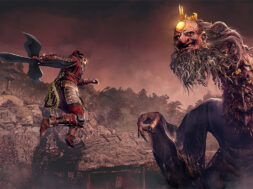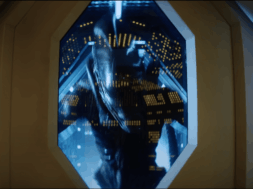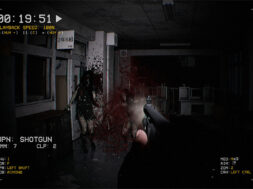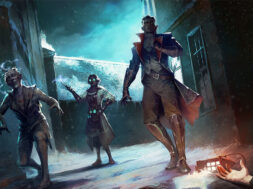When players think of horror games their minds usually don’t go anywhere near portable systems. Limited buttons and hardware have often left successful horror series off of the platforms, and it’s mainly been a genre primarily seen on consoles. Despite these disadvantages, some developers have had success in creating handheld horror games, and with the recent success of the more powerful Nintendo Switch, it’s quite possible that we’ll see a resurgence in scares that can be had on the go as many of the historical problems are no longer relevant.
Until then let’s take a look at 10 games that showed how successful the genre can be when done right on a handheld.
Clock Tower (Wonderswan)

While the grayscale visuals might lessen the impact that Clock Tower’s fantastic atmosphere had on players, there’s no denying that the faithful Wonderswan port was an impressive technical feat. The point and click gameplay of the Super Famicom original is entirely intact, and the menacing Scissorman still manages to instill fear in players. Even in 2018, players can easily find themselves engrossed in the tale of the Barrows family.
Silent Hill: Shattered Memories (PlayStation Portable)

Despite lacking the motion controls that made the original Wii version so unique, the PSP version of Shattered Memories showed that the handheld could handle console experiences well. The visual downgrades are obvious, but the game’s biggest strength remains its fantastic reimagining of Harry Mason’s story. Shattered Memories’ inventive psychotherapy sessions proved just as powerful on the go.
Corpse Party: Book of Shadows (PlayStation Portable)

All three of the mainline Corpse Party titles have found portable success, but Book of Shadows manages to be the scariest of the bunch. This is due to the evocative imagery that is conjured up both on-screen and through text in the visual novel. It’s a great example of a horror game playing to the system’s strengths as it abandoned the adventure game template of the original.
Resident Evil: Revelations (Nintendo 3DS)

Resident Evil largely went back to its roots with Revelations, as it embraced the survival horror gameplay that brought the series to prominence rather than the straightforward action it had embraced over time. The result was a resounding success, and it’s one of the most visually impressive 3DS games to this day. As the console ports later proved, the 3DS’ smaller screen and lower resolution helped hide some of the rough spots, and the bite-sized horror was perfect for portable play.
Year Walk (iOS)

Swedish developer Simogo embraced their heritage with 2013’s Year Walk and managed to create one of the most unique mobile games in recent history. The adventure game is absolutely haunting and takes advantage of a companion app to help players unravel the game’s many mysteries. It’s a brilliant example of a title taking advantage of its platform and shows that mobile gaming can be a strength, not a weakness if designed from the ground up.
Silent Hill Play Novel (Game Boy Advance)

Not many know that the original Silent Hill found its way to Game Boy Advance thanks to a unique version of Konami’s horror hit. Rather than trying to cram the adventure onto a system it wasn’t designed for, it instead presented the story as an interactive visual novel. It was only released in Japan, but fans have translated this cool piece of history into English.
Dead Space (iOS)

Despite serving as a side story to the main game, Electronic Arts pulled out all of the stops in creating a mobile version of the third-person shooter. It featured incredible production values at the time, and the gameplay was just as tense as ever thanks to a redesigned control scheme that alleviated the need for a controller. Unfortunately, despite how well it transitioned the iOS version of Dead Space is no longer available on the App Store. Perhaps proving that the perils of digital distribution are the greatest horror of all.
Resident Evil Gaiden (Game Boy Color)

While not without its fair share of problems, Capcom’s initial attempt at taking Resident Evil portable should be applauded. The game stars Barry Burton and Leon Kennedy as they explore a bio-organic weapon filled ship. It has a shockingly great storyline filled with twists, and a new top-down perspective works generally well. Combat is somewhat clunky, as first-person shooting is handled via a constantly moving reticle, but it’s a smartly designed title that manages to rely on the survival aspect of survival-horror.
Five Nights At Freddy’s (iOS)

By far the biggest success from a sales perspective on this list, the iOS version of Five Nights at Freddy’s manages to translate all of its jump scares to the small screen without fail. Like the PC version, players have to manage their electrical power while they check camera feeds in order to avoid the monstrous animatronic animals that roam the pizza parlor. It’s a remarkably well-designed horror game, and its simplicity helps it shine brightly on mobile.
Lone Survivor (PlayStation Vita)

Lone Survivor underscores one important lesson that is seen throughout this list: handheld horror games often can’t rely on technical achievements for scares. While the genre has often been at the forefront of game tech (even as recent as Resident Evil VII’s embrace of virtual reality), even a pixel-based game can keep players on edge if the writing is good and an atmosphere is properly built. Lone Survivor manages to achieve both of those goals, and it’s a great game on any platform because of it.
Bonus: The Pinball of the Dead (Game Boy Advance)

While not the purest of horror games, SEGA’s pinball adaptation of The House of the Dead is too good not to mention on this list. Each of the game’s three tables has players mowing through zombies by strategically shooting the ball, and there are six great boss battles that give the game a traditional sense of progression. It’s proof that even when the tech isn’t quite there, a good developer can find a way to make a horror series work on handhelds with some tweaks.









